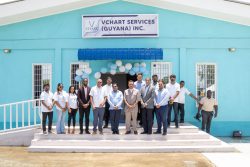Government has identified Moco Moco, Kato and Tumatumari as priority sites for small hydropower systems and says a 300 megawatts hydropower plant can cater for Guyana’s current and future energy needs but in its latest outline of plans to lower carbon emissions, makes no mention of Amaila Falls.
“Guyana will seek to construct and/or promote the construction of small hydro systems at suitable locations across the country. Government also plans to construct and/or promote the construction of small hydro systems in areas such as Moco Moco, Kato and Tumatumari, and will power all of the new townships, starting with Bartica, using alternative energy sources,” government says in its Intended Nationally Determined Contribution (INDC) which is to be submitted to the United Nations Frame-work Convention on Cli-mate Change (UNFCCC).
INDCs are national climate action plans/goals for the post-2020 time period that countries submit to the UNFCCC in preparation for a new international climate agreement. Countries across the globe have committed to create a new international climate agreement by the conclusion of the UNFCCC Conference of the Parties (COP-21) in Paris in December. The COP-21 meeting will seek a binding agreement on how to share the burden of capping global warming at 2 degrees Celsius above pre-industrial levels or lower.
The time frame associated with Guyana’s INDC is for the period up to 2025.
In relation to energy, Guyana says that it will continue to examine all sources of energy – fossil fuels, wind, solar, bagasse and hydropower. Accord-ing to the document, as part of its “unconditional contributions,” Guyana will seek to construct and/or promote the construction of small hydro systems at suitable locations across the country. It says that government plans to construct and/or promote the construction of small hydro systems in areas such as Moco Moco, Kato and Tumatumari, and will power all of the new townships, starting with Bartica, using alternative energy sources.
“Independent power producers and suppliers will be encouraged to construct energy farms and sell energy to the national grid,” it adds.
Both Moco Moco and Tumatumari have hydro-power plants but the one at Moco Moco was damaged by a landslide in 2003 and never fixed. It has since been severely vandalized. The hydroelectricity station at Tumatumari Falls on the Potaro River was the first hydropower station in Guyana and was closed in the early 1960s following a prolonged workers’ strike. It was put back into use in 1976 by the Guyana National Service to supply power to its administrative centre and other activities and up to 1987, one turbine functioned. Since then it has not worked but currently, a private company is working to rehabilitate it.
In the case of Kato, almost €1.8 million in European Union (EU) funding for the proposed Kato Hydropower Project expired in February and government has said that it is looking for new funding.
In Guyana’s INDC, in relation to “conditional contributions” for energy, government says that feasibility studies for a large hydropower development in the Mazaruni region will be pursued with collaboration from the Government of Brazil. “It is uncertain at this time what size of facility will be pursued, and in which location,” the document says.
It noted that according to the International Renewable Energy Agency (IRENA), large hydropower plants with storage typically range from as low as US$1,050/kW to as high as US$7,650/kW while the range for small hydropower projects is between US$1300/kW and US$8,000/kW.
“A 300MW hydropower plant to cater for Guyana’s current and future energy needs should therefore cost between US$315 million to US$2,295 million,” it states.
No mention is made of the Amaila Falls Hydro-power Project (AFHP) which was being pursued by the previous PPP/C administration. A US$42M access road was built and is currently not being used and in January, then Minister of Public Works Robeson Benn had said that the ministry will be spending $200M every year to maintain the road.
Norway recently urged the APNU+AFC administration to consider the merits of the AFHP since Guyana stands to lose over $16 billion previously earmarked for the project if it fails to come up with a plan for “transformational” renewable energy sources that can be realised in the next few years.
Norway had strongly supported the AFHP, the flagship project of the previous PPP/C administration’s Low Carbon Deve-lopment Strategy (LCDS,) which was envisioned to deliver a steady source of affordable, reliable, clean and renewable energy. The 165-megawatt project was supposed to eliminate at least 92% of Guyana’s energy-related greenhouse gas emissions and it was said that this would likely make Guyana the world’s number one user of renewable energy by 2017.
Meanwhile, government also highlighted other “conditional contributions” for energy. It says that options for interconnecting renewable energy generators to the grid will be reviewed and explored towards the implementation of grid-tied systems and net-metering platform. “Once proven beneficial to all parties, grid-tie options can be encouraged as a means of reducing investment in fossil-based generators and meeting incremental demand from renewable energy sources,” the INDC says.
It says that for supplying hinterland communities, Guyana is interested in piloting small scale fermentation and distillation techniques for the production of ethanol and biodiesel. “If these conditional contributions are fully funded and implemented, they can represent approximately 30 percent of Guyana’s total energy mix,” the document says.
It said that implementation of Guyana’s conditional contributions in energy is estimated at US$315 million – US$2,295 million.
Guyana’s INDC also covers the forestry sectors and proposed an Emissions Reductions Programme (ERP) in forestry.
According to the document, implementation of Guyana’s INDC up to 2025 is estimated at US$4.49 billion which comprises US$0.6 billion for forestry, US$2.29 billion for energy and US$1.6 billion for adaptation.
The document noted that it is assumed that the Green Climate Fund will be fully operationalized and begin disbursing from 2016. It is also assumed that Small island Deve-loping States (SIDS), and in particular, coastal low lying countries such as Guyana, will received preferential access and special consideration in access to financing. Sectorally, it is also assumed that INDC’s for REDD+ and renewable energy will receive adequate financing in a timely manner.









